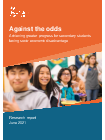Research: Against the odds

Achieving greater progress for secondary students facing socio-economic disadvantage
Documents
Against the odds
PDF, 1.33MB, 76 pages
This file may not be suitable for users of assistive technology.
Request an accessible format.
If you use assistive technology (such as a screen reader) and need aversion of this document in a more accessible format, please email [email protected].Please tell us what format you need. It will help us if you say what assistive technology you use.
Details
In this report, the Social Mobility Commission and the Education Observatory at the University of Wolverhampton provide one of the most thorough investigations to date on the characteristics of secondary schools able to start closing the progress gap and achieve better outcomes for disadvantaged pupils.
Key findings include:
- There is no single strategy / intervention that can be clearly implemented in all, or even a majority of, schools to reduce the progress gap.
- A school’s absence rate is the strongest predictive factor of the progress made by its pupil premium students, but in most schools, it is only a minor focus of pupil premium policy and is not currently a factor in the calculation of what schools receive.
- A school’s staff culture regarding the pupil premium is an important factor in tackling socio-economic disadvantage.
- Some schools face extreme contextual challenges, which are associated with lower levels of progress among students allocated pupil premium funding.
- Teachers believe that quality teaching and personalisation are the most effective ways to support students facing socio-economic disadvantage, but these beliefs are not always translated into practice.
This report contains recommendations for national policy makers and school leaders, based on our findings.
The report authors have also created a pupil premium primer to help schools take a longer-term approach to tackling socio-economic disadvantage. The primer’s resources enable schools to compare their contexts to other schools, learn about the journeys of similar schools, explore the attitudes of their staff, and consider the impact of policies on students’ wellbeing. They do not provide a simple solution, but enable school leaders to consider their pupil premium strategy more broadly, knowing that deeper, more prolonged effort is necessary to bring about lasting change.
Published 30 June 2021











Responses